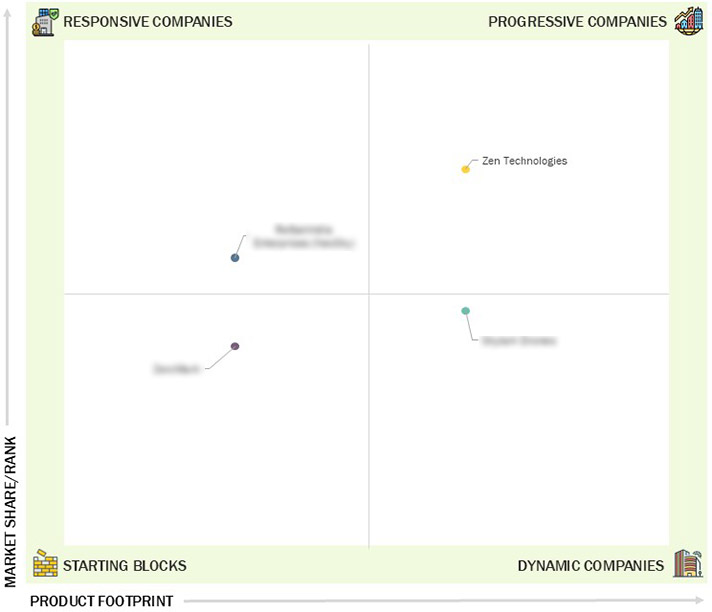Comparing 4 vendors in Anti-Drone Startups across 0 criteria.
Anti-drone systems are designed to detect, track, identify, and neutralize unauthorized drones that pose risks to safety, privacy, and security. These systems use a combination of radar, RF scanning, electro-optical sensors, and jamming or laser-based countermeasures to protect critical infrastructure, public events, and sensitive areas. The market is expanding due to increasing drone-related threats, technological advancements, and growing adoption across defense, commercial, and homeland security sectors. Integration with AI and command systems enhances their effectiveness, making them vital in modern security strategies.
Market Leadership Quadrant
1.1 Study Objectives
1.2 Market Definition
1.3 Study Scope
1.3.1 Markets Covered and Regional Scope
1.3.2 Inclusions and Exclusions
1.3.3 Years Considered
1.4 Currency Considered
1.5 Unit Considered
1.6 Limitations
1.7 Stakeholders
1.8 Summary of Changes
2.1 Introduction
2.2 Market Dynamics
2.2.1 Drivers
2.2.1.1 Growing adoption of drone countermeasures in defense sector
2.2.1.2 Increasing development of advanced anti-drone technologies
amid rising criminal activities
2.2.1.3 Rising unauthorized drone sightings near airports globally
2.2.1.4 Rapid advances in detection and jamming technologies
2.2.2 Restraints
2.2.2.1 Requirement for substantial upfront capital
2.2.2.2 Operational complexities and risk of false positives in
drone detection
2.2.2.3 Lack of harmonized standards and regulations across
geographies
2.2.3 Opportunities
2.2.3.1 Integration of AI and ML into drone detection and tracking
platforms
2.2.3.2 Expansion of smart city infrastructure
2.2.3.3 Increasing complexity of drone threats
2.2.4 Challenges
2.2.4.1 Vulnerabilities to hacking
2.2.4.2 Integration with existing security and surveillance
ecosystems
2.3 Value Chain Analysis
2.4 Ecosystem Analysis
2.5 Investment and Funding Scenario
2.6 Trends/Disruptions Impacting Customer Business
2.7 Technology Analysis
2.7.1 Key Technologies
2.7.1.1 Artificial intelligence (AI) and machine learning (ML)
2.7.1.2 High-energy laser systems
2.7.1.3 High-powered microwave (HPM) weapons
2.7.1.4 Interceptor drones (autonomous UAV-based neutralizers)
2.7.2 Complementary Technologies
2.7.2.1 Command and control systems
2.7.2.2 Sensor fusion algorithms
2.7.3 Adjacent Technologies
2.7.3.1 Cybersecurity and threat intelligence platforms
2.7.3.2 Satellite communication (SATCOM)
2.7.3.3 Blockchain
2.8 Impact of AI/Gen AI on Anti-Drone Market
2.9 Key Conferences and Events, 2025–2026
2.10 Impact of US Tariff on Anti-Drone Market
2.10.1 Introduction
2.10.2 Key Tariff Rates
2.10.3 Price Impact Analysis
2.10.4 Impact on Countries/Regions
2.10.4.1 US
2.10.4.2 Europe
2.10.4.3 Asia Pacific
2.10.5 Impact on Verticals
3.1 Overview
3.2 Key Player Strategies/Right to Win, 2020–2025
3.3 Market Share Analysis, 2024
3.4 Revenue Analysis, 2020–2024
3.5 Company Valuation and Financial Metrics
3.6 Product Comparison
3.7 Company Evaluation Matrix: Startups/SMEs, 2024
3.7.1 Progressive Companies
3.7.2 Responsive Companies
3.7.3 Dynamic Companies
3.7.4 Starting Blocks
3.7.5 Competitive Benchmarking: Startups/SMEs, 2024
3.7.5.1 Detailed list of key startups/SMEs
3.7.5.2 Competitive benchmarking of key startups/SMEs
3.8 Competitive Scenario
3.8.1 Product Launches
3.8.2 Deals
3.8.3 Other Developments
4.1 ZEN TECHNOLOGIES LIMITED
4.1.1 Business overview
4.1.2 Products/Solutions/Services offered
4.1.3 Recent developments
4.2 SKYLARK DRONES
4.2.1 Business overview
4.2.2 Products/Solutions/Services offered
4.2.3 Recent developments
4.3 ZEROMARK
4.3.1 Business overview
4.3.2 Products/Solutions/Services offered
4.3.3 Recent developments
4.4 RATTANINDIA ENTERPRISES (NEOSKY)
4.4.1 Business overview
4.4.2 Products/Solutions/Services offered
4.4.3 Recent developments


 Railway PRO
Railway PRO
 Oct 2025
Oct 2025

